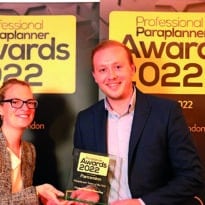Cooper Parry Wealth scooped Paraplanner Team of the Year for the second year running at the Professional Paraplanner awards. Here, Financial Planner Manager David Carroll tells Rob Kingsbury how the team has recently restructured to play to its strengths
Cooper Parry Wealth has recently changed the structure of its wealth management operation. As such it has broken with the usual role descriptions of the financial planning market. Paraplanners are now called financial planners.
David Carroll is the Financial Planner Manager. The catalyst for change, he says was 12 months of winning “a lot more clients which impacted the workload of the business and our capacity to keep delivering at the level we wanted.
“So we went back to the drawing board as a leadership team and looked at where we were. We benchmarked ourselves against financial planning firms in the US, where the market is more advanced, and the senior management team took three days away to look at how we could better structure the business for growth.”
The result, Carroll says, is a move to a strengths-based organisation.
In essence, that is trying to understand what each member of the team’s strengths are and making sure their skills are being applied in the right place and in the right way.
“We know the part everyone is playing now but we’re looking at whether they in the right role, could they be great at doing something else, and also who is doing what within the bigger picture of the business.”
It has led to the restructuring of the paraplanner role into two specific roles. Carroll explains: “From a paraplanning team perspective, we looked at those that had the more client-facing skills sets and those who were more technical, detail focussed behind-the-scenes guys, and that led to a split in the team. So, now we have paraplanners, the technical guys, and what we are calling financial planners, who are the paraplanners who effectively front the client relationships.
“The paraplanning department does the leg work on each case and then feeds the work into the financial planners, who will take responsibility for the level of work being produced and sign off on it. So they are still doing paraplanning work but not the nuts and bolts of it.
“They are client facing and attend meetings. They are CF30 and Level 6 qualified and are competent to give advice. They still operate as paraplanners but they own the work and they own the client relationship.”
The firm’s wealth managers (the traditional financial planner role), Carroll says, are now termed relationship managers. “They will oversee the client relationship at a higher level. They can attend on the day of the client meeting, receive a brief from the financial planner and be set for the meeting – they don’t have the prep time or the hands-on involvement in the checking of the work – the financial planner has responsibility for that. But they do have the overall responsibility for the client and developing the long-term relationship with them.”
The financial planner role is, in effect, a hybrid role between paraplanning and the traditional wealth manager/financial planner role. “The financial planners are tasked with adding the wow, the value add to every case,” Carroll says. “They will be spending the time thinking about the planning pieces, about different scenarios in cashflow forecasting, stress testing the planning, and the things that can get lost in the process and compliance. The financial planners are being given more freedom to run with the pieces the clients value more.”
Client meetings
As an example of how the system works Carroll describes a situation where the firm is looking to win a new client.
“The first meeting we have with the client is a ‘right fit’ meeting, where we gauge whether we can work with the client and vice versa. That meeting will be the responsibility of the relationship manager. If we move forward with the client, then the relationship manager and the financial planner will jointly host the next three meetings; the discovery, planning and implementation meetings. Once the client is fully on board, where we are touching base and for straightforward meetings the financial planner will run them.
“We have a six week catch up meeting with the client to review what’s happened and make sure nothing else needs to be done. That will be taken by the financial planner and maybe one of the paraplanning or client support team members (administration in a traditional firm). We then have a six-monthly interim meeting which is again driven by the financial planner.”
The criteria for who attends and runs the meetings depends on where the team member adds value, Carroll explains. “The people responsible for the particular actions will be in the relevant meetings. For example, we recognise that mistakes in paper work have led to issues in the past so now if there is paper work needed, the individual from the client support team who has prepared the paperwork and knows what’s required will be there to ensure all the details are captured and the sign offs are completed. They take ownership for that part of the process.”
The relationship manager comes back in at the annual review, as that is focussed on the long-term relationship with the client.
“The relationship manager engages with the client at a higher level, rather than getting involved in the detail of the financial planning. As a result, they could have more touchpoints with the client but it won’t necessarily be in the office or over some paperwork,” Carroll says.
Evolving process
The financial planner role is not one into which the firm would hire a traditional financial planner or wealth manage, Carroll says. “It needs to have a paraplanner’s focus on detail and technical knowledge.”
From the client’s perspective, every person who will be dealing with their financial planning is named and they are given their contact details.
“Every client knows everyone from day one and also that there is a real team looking after their financial planning not just an individual.”
Introducing the strengths-based approach, Carroll says, “is about identifying where are your strengths and knowledge, and you do that bit. It’s about making the process more robust and making the experience better for the client.”
Having just implemented the new structure, Carroll says the firm expects there will be challenges with it. “It will evolve. Our business is built on evolution and reacting to change, so in a year’s time we’d expect it to be different. But we think it is pioneering and the way forward.”




























